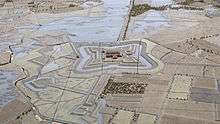Fort de Roovere

Coordinates: 51°31′44″N 4°18′04″E / 51.52889°N 4.30111°E
Fort De Roovere is an earthen fort, constructed as part of the Dutch Water Line, (Hollandse Waterlinie), a series of water-based defences conceived by Maurice of Nassau in the early 17th century. It is near Halsteren.
In 1747, during the Austrian War of Succession (1740–1748) the fort was under siege by the French. This siege has been extensively documented. Eventually, the fortress Bergen op Zoom fell and the siege was abandoned.
Nowadays the fort is open from the ‘back’, and the ‘front’ consists of two bastions. The fort has a dry moat and the banks are overgrown with trees.
Renovation
Over the years the de Roovere fort had fallen into major disrepair, but a foundation has now been established, "Friends of Fort de Roovere", whose goal is to make sure the fort is not forgotten.
In the middle of 2010, extensive renovation of the fort began with the removal of the undergrowth and a deepening of the old moat so that the fort could be more easily recognizable as such. In addition, a bridge was built to access the fort across its moat, done with and unusual partially submerged bridge, rendering it practically invisible. The bridge has taken on the name "The Moses Bridge", as it appears to divide the moat's waters.[1][2]
The clearing of the area led to many local protests. Remarkably, very little to no interest was paid to archeological research as there should be traces of the French siege nearby. Local amateurs with metal detectors still regularly find cannonballs there, which must have come from the siege.
The improvements include recreational functions, and the site lies on several routes for cycling and hiking.
References
- ↑ "Sunken Pedestrian Bridge in the Netherlands Parts Moat Waters Like Moses!". Inhabitat. Retrieved 18 October 2017.
- ↑ "'Invisible' bridge UNDER moat waterline of 17th century fortress, built by Dutch engineers". Daily Mail Online. November 16, 2011. Retrieved July 7, 2015.
External links
- Holy Moses! Miraculous 'bridge' parts the water at top tourist attraction, The Daily Mail, 16 Nov. 2011
- The official tourism website of the province of Brabant, the Netherlands on Fort de Roovere.
- Amazing places on earth
- Walking across the Moses Bridge
- Atlas Obscura
- Bridge parts moat waters like Moses